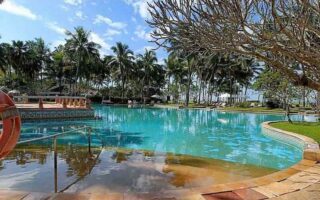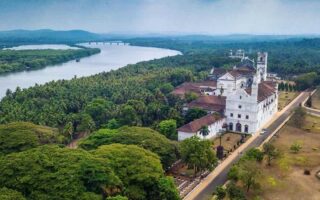People hardly ever think of pilgrimage in Goa. But, in fact, people having spiritual beliefs will consider Goa as a heart for pilgrimage. Pilgrimage in Goa can be interesting since the entire state is dotted with several churches. And contrary to the conventional belief, that Goa is famous for its magnificent churches, the place also treasures variety of temples.
Some of the noted temples of Goa are listed below.
Mahalasa Temple
- Location: Mardol village, Ponda, North Goa
- Highlights: Six storied ornamental lamp pillar
- Festival: Annual Jatra, Jayanchi Pooja, Kojagiri Purnima
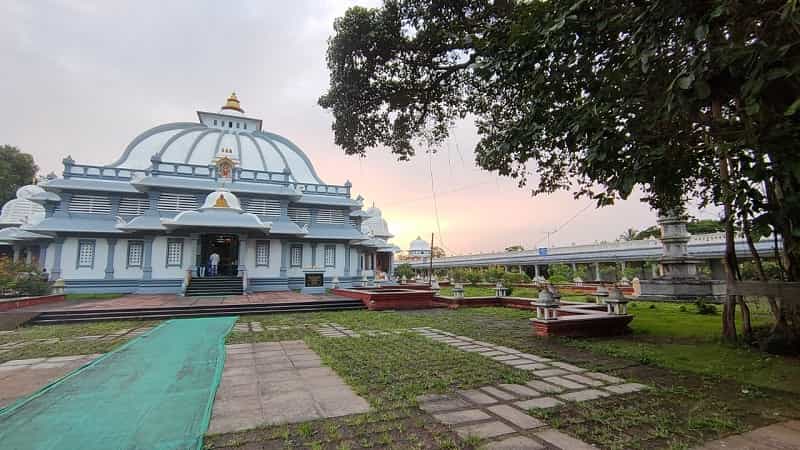
Mahalasa temple in Goa is a renowned one and it is commonly called Mahalasa Narayani Temple. This temple is dedicated to Hindu goddess Mahalasa.
Mahalasa temple is one of the plush temples that you find in Goa. This temple is not just a temple for devotees it is also a fine example of workmanship that draws interest of art lovers. It is laden with rich works of art both in its exterior and interior.
Unique Feature
The most interesting feature of this temple lies in its deity. The deity, though a goddess, wears a sacred thread that is only worn by male gods and male Brahmins. This is due to the fact that Goddess Mahalasa is an avatar of Lord Vishnu. Since the deity is a female incarnation of Vishnu, it is also called “Mahalasa Narayani”. This feature gives singular importance to this deity and consequently to this temple as well.
Prime Attraction
The outstanding Mahalasa temple of Goa has an awe-inspiring lamp tower situated in its courtyard. The lamp tower is six-storied; it is 400 feet high and has 21 rings of lamp around it which holds 150m lamps. A fascinating scene is unfolded when all the lamps are lit.
This temple has one more striking object for which it is famous in Goa. There is a huge brass bell within the temple premises which is devoid of its ringer. It is believed that Devi Mahalasa will punish the person who lies when ringing this bell. Hence, the ringer is attached only when someone wants to testify. People had such a strong faith in this belief that during the Portuguese rule in Goa, testimony of this was accepted by court of law.
Festival
On every Sunday the temple organizes Palki Seva to the deity. The deity is taken for a ride on highly ornate palanquin, loaded with flowers.
Navaratri is also an important festival of this temple that draws several devotees all over India.
History
This temple was demolished during the 26th century, when Adil Shah and his troops raided the original temple. The deity was however rescued and now restored in its new location at Mardol village. Previously the deity resided in a temple at Salcete Taluka.
Mangueshi Temple
- Location: Priol, Ponda Taluka, North Goa district
- Significance: Dedicated to Lord Manguesh, a form of Lord Shiva
- Festivals: Annual Jatra held every year in January
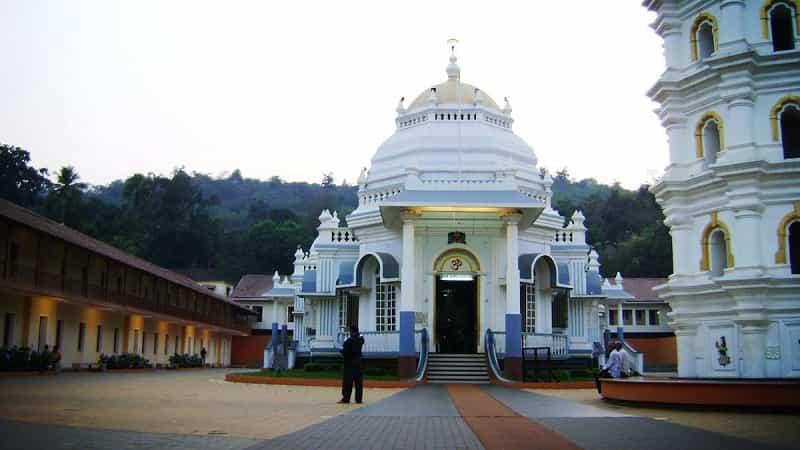
Among the scores of remarkable temples that dot the land of Goa, Mangueshi Temple is a well known one. Like most of the Goan temples, threat of destruction loomed large on Mangueshi temple. And thus the deity of this temple was transferred from its original location to Priol. During the time of the transfer of the location Priol was under the territory of Adil Shah. This time period offers a historical importance to this deity apart from its spiritual value. The deity on the lings inside the temple is almost 400 years old.
After the deity of Mangueshi temple was shifted in 1560, it underwent several rounds of renovation. Most of the renovations took place during the reign of Marathas. During the renovation of 1973, a golden vessel was attached on the top of the dome.
Few Words on Temple Architecture and Objects
This temple is filled with fascinating spectacles from its main entrance. The first noted feature of this temple is its architecture. The architecture of the temple displays an amalgamation of Hindu, Muslim and Christian styles of construction.
The seven storey lamp pillar stands tall at the temple courtyard just next to the main entrance. One must not lose the opportunity to view the wondrous scene when all the lamps of this pillar are lit.
The temple has a magnificent water tank which is supposed to be the oldest part of the temple. The noted feature of this temple is its pillars. The embellished pillars of the temple are the most beautiful one among all the temples of Goa.
The temple has a massively spacious Sabha Griha, which can accommodate more than 500 people. Apart from the Shiva Linga, there are several other shrines to see. Most people folk around this temple to see the prominent figure of Nandi Bull, which is considered to be the vehicle of Lord Shiva.
Festivals
The annual Jatra festival of this temple is held in the month of January. Pedestrians and local people can see the deity or lings closely as it is carried for a ride on a palanquin during this festival.
Know the Route
The temple is located very near to National Highway 4A. This highway connects Ponda to Panaji. You can get plenty of local transports to reach this famous landmark easily.
Shree Mahalaxmi Temple
- Location: Panaji city, North Goa district
- Significance: Dedicated to Goddess Mahalaxmi
- Festival: Maruti Jatra festival
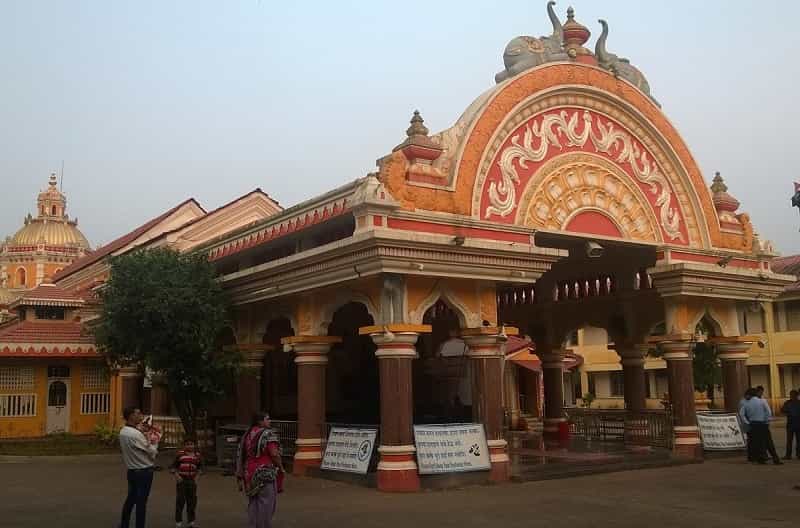
People barely hear about temples in Goa. In fact, the homeland of Goa is proud to have several temples, rich in art and heritage. Mahalaxmi temple of Goa is one such temple that will break the myth that Goa is only the place for outstanding churches.
Mahalaxmi temple Goa is located in the heart of Panaji City and is devoted to Mahalaxmi or the goddess of wealth.
About the Construction
The Mahalaxmi temple of Goa has been built in the hollows of a valley. The temple has a small arched entrance and above it the naubat khana has been constructed. In the courtyard several Gods are displayed with a red plastered covering.
You can see a pair of amazing domes on the entrance of the temple’s main building. Both the domes have a curiously flattened look which makes them unique and noteworthy. The main tower of the Mahalaxmi temple Goa stands tall over the entire construction. The main tower is fitted with a lantern which gives it a look of a gleaming star during the evenings.
The Mandapa or the main floor of the temple is quite spacious. This floor is the prime attraction during festival days since all the musical and dance programs are performed here. The floor is surrounded arts of different Gods. All those art works depict tales of Hindu Gods and Goddesses.
The most notable feature of this temple is a set of 24, lightly painted, wooden panels. These wooden panels describe you the different scenes of Bhagwat Puran, story of Lord Krishna and Vishnu’s 8th incarnation.
Best time for tourists and devotees
The best time to visit this temple is during the months of January and February. The pompous festival named Maruti Jatra is held during this time every year.
History
The temple is first of its kind to have been built after the invasion by Portuguese ruler Alfonse de Albuquerque. The temple was approved for construction by Portuguese rulers in 1818. Since it was established, it has undergone massive renovations, latest of which was completed in 1993.
Naguesh Temple
- Location: Bandode village, Ponda, North Goa district
- Deity: Lord Naguesh, incarnation of Lord Shiva
- Established in: 1413 AD.
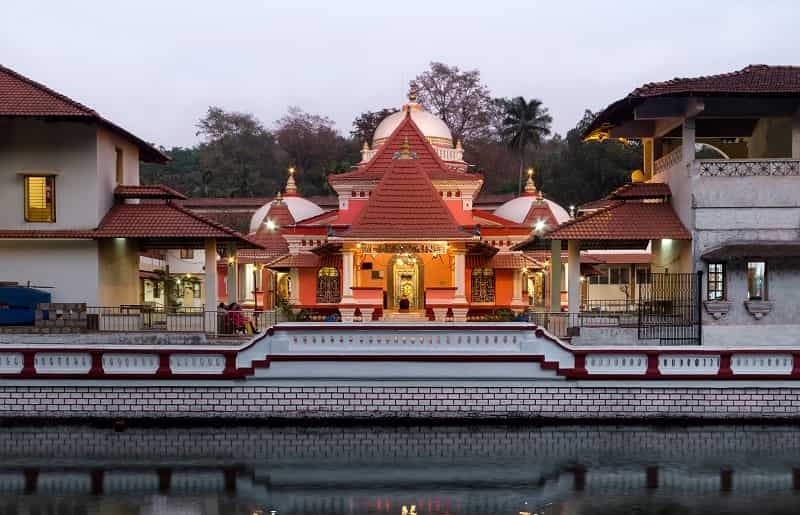
Temples of Goa are eye-catching and are worth a visit. One will abide by this fact if he/she takes a tour at the Naguesh temple located in Bandode village. This highly decorated temple is dedicated to Lord Naguesh, an avatar of Lord Shiva. You can capture some of the finest collection of workmanship in Naguesh temple that are centuries old.
You can trace back the origins of this temple to 1413. During that time, Veer Pratap Devaraya of Vijayanagara Empire ruled this land. Unlike most of the temples in Goa, Naguesh temple never confronted the threat of persecution. Naturally this gives all the devotees a scope to see its original location even today.
Things to See
The current structure of the temple is a result of massive renovation of 1880. The temple is in good state of preservation presently.
The ponderous black granite figure of Nandi Bull will catch your glance first when you will cross the main entrance.
The magnificent water tank of the temple will definitely draw your attention. It surrounded by palm trees and it is provided with a constant supply of fresh water. This tank is a distinctive feature of the temple and is famous among all the temples of Goa. The tank is placed intelligently so that, the reflection of Lord Naguesh and lighted lamps is visible in its inner sanctum.
The five storey lamp pillar within the temple premises will surely tempt you to take a snap, once all its lamps are lit.
Surroundings
The temple is situated within a verdant backdrop which offers it an ideal look of serenity. The temple is enveloped by hills on its three sides, all of which has several springs in it, and river Aghanashini on the fourth side. You will be amazed to see the lush green fields encompassing the temple, making the ambience aesthetically high.
You can also see the royal palace of King Sunda, which is located very near to the temple.
Route to the Temple
Once you reach Ponda you will get plenty of local transport to reach the temple. In case you want to come by personal vehicles then take National Highway 4A, which connects Ponda to Panaji, will be the ideal one. The temple is just four km east from Ponda.
History
The temple stands in its original location today since the part of Ponda where it stands now was never under the territory of Portuguese colonizers. It is believed that the deity of Naguesh temple was brought by Parashuram along with other Saraswat Brahmins who migrated from South India.
Saptakoteshwar Temple
- Location: 37-km from Panaji, Goa
- Deity: Lord Shiva
- Houses: Dhara-Linga
- Architecture: Medieval Architecture Style
- Festival: Gokulashtami
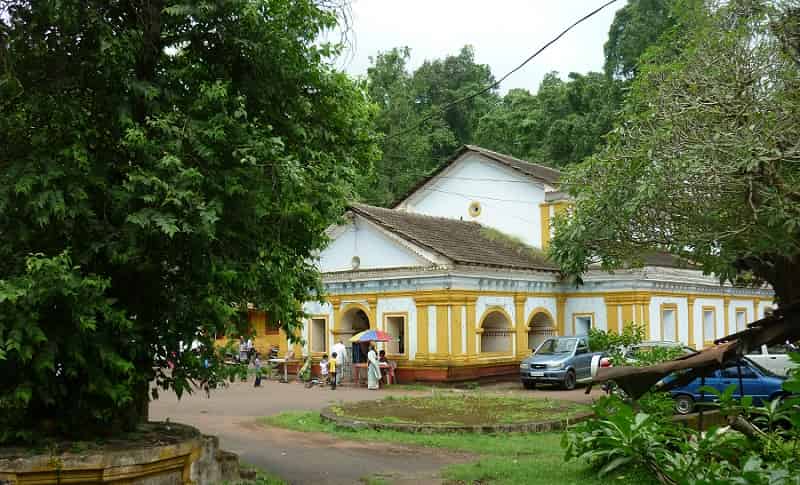
When one plans for a Goa trip, he/she gets thrilled to see the beaches and churches of Goa. But unfortunately they miss out the plethora of intricately designed temples that reside in the land of Goa. Surprisingly, Goa has some of the noteworthy Hindu temples within its boundaries. These temples have a significant impact on the social lives of the people staying around. The people staying near and in the surrounding villages of these temples consider these temples not just a place for worship but also a place to shed off their worries and sorrows.
Among the abundant temples of Goa, Narven – Bicholim Shri Saptakoteshwar temple is a renowned one. Not far away from Panaji, this temple was originally in a different site named Divar Island, where it was destroyed by the Portuguese to build a chapel on the same site. The image of the deity was then shifted to Naroa where the present temple was built on the order of Shivaji Maharaja.
Myth about the Temple
One of the foremost Hindu temples in India, Narven- Bicholim Shri Saptakoteshwar temple, the deity of this temple is an incarnation of Lord Shiva. It is believed that this incarnation of Lord Shiva appeared before the sages as a result of a lengthy prayer that continued for seven crore years.
Rise and Fall of the Temple Glory
The Narven- Bicholim Shri Saptakoteshwar temple had faced several ups and downs of its glory in the past. This temple was worshipped as a patron God during the dynasty of Kadamba. In the year 1352, the temple was dishonored by Sultan Hasan Gangu. However, the disgrace brought to this temple by Gangu was soon replied boldly in 1367 by Vijayanagara King Harihara. He again brought back the lost glory to this temple. The entry of Portuguese in Goa again brought back the tough days of this temple as they demolished its original structure in Divar Island under the patronage of Chhatrapati Shivaji, the temple was rebuild.
If you are fascinated and moved by the history of this temple then do visit the temple during festival days held in Gokulashtami. This festival is celebrated with much pomp and pageantry, which gives a glorious scene for the tourists to watch.
Mahadeva Temple – Tambdi Surla
- Location: Tambdi Surla, 69-km from Panaji, Goa
- Presiding Deity: Lord Shiva
- Built In: 12th Century
- Architecture : Yadava Style Architecture
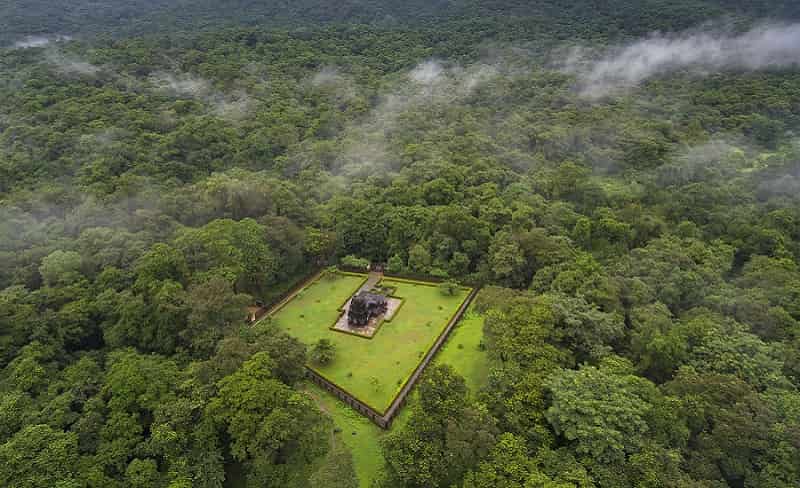
The rich abundance of Goan temples is often missed out by tourists and they engage themselves in sunbathing by the sunny seaside. It is a surprise for all tourists to know that some of the intricately designed temples of Goa are famed nationally. One such temple is Mahadev temple at Tambdi Surla.
The Mahadev temple at Tambdi Surla is a small yet exquisite temple which was built during the 12th century. The uniqueness of the temples lies in its age. As it is the oldest temple in Goa.
Architecture of the Temple
The Mahadev temple at Tambdi Surla is the only example of temple architecture during the pre-Portuguese era.
This black basalt temple bears fine artistry of stone carving in and around its structure. These stone carvings render loftiness to this small sized temple. The inner sanctum of the temple contains the Linga and the local legend which says, a huge King Cobra resides inside the temple premises.
All the interior structures of the temple like Antarala, Garbhagriha and Nandi Mandapa are built out of basalt. The Mandapa is pillared and all the pillars are embellished with elaborate carving of elephants. A chain supports the intricately designed ceiling of the temple. The temple ceiling bearing a huge lotus carved flawlessly shows the expertise of stone carving by the sculptor of its time.
Around the walls of the temple you will see various figures of the three chief Hindu Gods; Brahma, Vishnu and Maheshwara. Amidst such an intricately designed interior and exterior of the temple the only plain structure is the roof covering the Mandapa. It is made out of grey colored sloping slabs. In the middle of the Mandapa you will find a headless Nandi Bull.
The temple is facing the east, which allows the first morning sunrays to enter in the temple premises. Apart from the main Mandapa, there is one more Mandapa at the inner sanctum of the temple. The top of this Mandapa is incomplete. Some people assume that this was demolished in the past.
The site of the temple testifies its survival, despite the rampant demolition of temples during Portuguese era. The temple is situated in a place which cannot be easily accessed and is much away from the Portuguese settlements.
Festivals and Fairs
The “Agmic Puja” is performed in this temple even today with all the rituals that were followed in the past. This Puja will allow you to walk down the lanes of history when this Puja was performed exactly in this same fashion.
The temple also performs the Mahashivratri Festival very pompously. This is a festival worth watching as the temple and its locality comes in a festive mood.
Mallikarjun Temple
- Location: Shristhal, Canacona, South Goa district
- Construction Period: 16th century
- Significance: Dedicated to Lord Mallikarjuna, form of Lord Shiva
- Festivals: Annual Jatra, Veeramel festival celebrated every year in the month of April
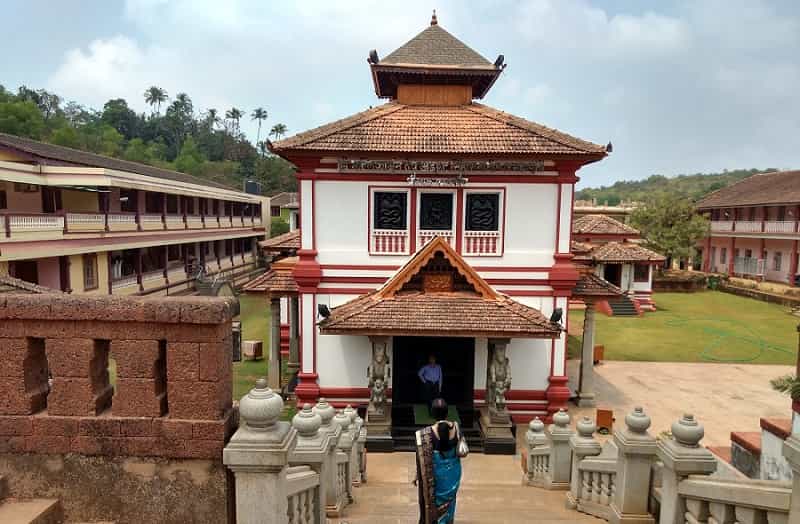
Goa is always believed to hold a plethora of churches, and seldom are the temples of Goa mentioned. Mallikarjun Temple in Goa will nullify the conventional thought that the land of Goa has decorative churches only.
The Mallikarjun Temple is named after Lord Mallikarjun, who is believed to be an incarnation of Lord Shiva. This holy place is situated among thick greenery and it is one of the oldest temples of Goa. The construction of this temple dates back to the 16th century, during the era of Kshatriya Samaj. The details about its period of construction can be found on a plaque near the temple dome.
Within the premises of Mallikarjun temple you can see 60 ancient Hindu deities. The temple is renowned for its variety of festivals.
Architecture
The temple is decorated wonderfully with wooden and silver carvings. These embellishments are a fine work of art by traditional Hindu sculptors and one can barely refrain from taking a snap. It is believed that this magnificent temple was erected by Habu Brahmins of Dravidian dynasty.
The pillars of the assembly hall in this temple bear some of the finest art works of its era. One of these massively decorated pillars is known to have been used as oracle pillar.
Festivals
The festivals organized by these temples present the age old rituals which were followed since the inception of this temple. There are several festivals that are held.
Shisharani Festival: This intriguing festival involves an interesting ritual. The term “Shisharani” implies cooking on a human head. During this festival rice is cooked in an earthen pot on the top of three men who lie on the ground, with their head covered with wet clothes. This ritual is performed every alternate year.
Jatra: This annual festival is unique among all the temples of Goa. On the day of the festival temple priests takes out the deity early in the morning. A procession starts from the temple door, carrying the deity along. The procession heads towards Kindlebag beach and it takes almost 2-3 hours to reach there. Several rituals are performed on the beach which involves a sacred bath to the deity. After the special bath the deity is carried back to the temple premises.
Ramnath Temple
- Location: Bandode village, Ponda, North Goa district
- Built In: 1566 AD
- Deity: Incarnation of Lord Shiva
- Festival: Annual Jatra
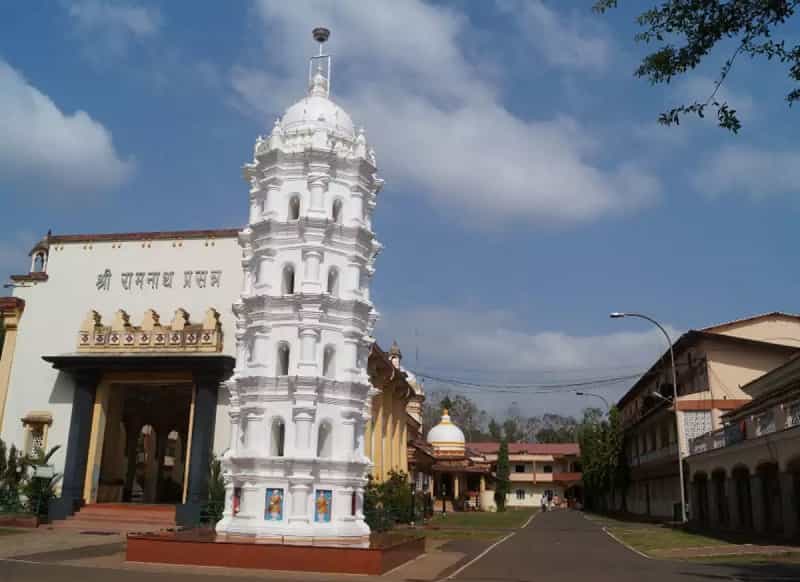
You can once again feel the famous mythology once you visit Shri Ramnath Temple in Ponda. Like many other temples in Goa Ramnath temple was also shifted from its original location in the fear of persecution by the Portuguese colonizers. The original location of the temple was at Loutolim. The present location was ruled by Bijapur Sultan when the deity was transferred from its original site.
Things to See
Like most of the temples of Goa, Shri Ramnath temple is decorated with wooden and stone carvings. Though most of the temple underwent renovations several times, yet some of its original construction still remains at your dismay.
The main building of the temple was massively reconstructed during 1905 leaving only the Mandapa or courtyard, which was only repaired. You can see the masonry finesse on the floors of the temple. The floor is decorated with red and green colors and you will find heavy round pillars bearing beautiful art work.
Several scenes from the famous mythology of Ramayana are painted all over the temple interiors. The wide array of chandeliers and lanterns in the inner sanctum are noteworthy features of the temple.
The five storey lamp pillar or Deepstambha makes a fascinating spectacle in the evening when all the lamps are lit. The lamp pillar is engraved with images of Hindu deities at its base which adds to its striking look.
Other Temples
The entire temple comprises of four temple with its precincts namely, Shri Laxminarayan, Shantadurga (Shanteri), Betal and Shri Sidhanath.
History
Shri Ramnath temple is backed by an interesting and curious tale that will evoke excitement to see the temple closely. It is believed that remorseful Lord Rama built this temple. After slaying the demon king Ravana in Lanka, Lord Rama was filled with repentance. He then decided to construct this temple, which is dedicated to Lord Shiva (Guru of ravana), to respect the famous demon king.
Laxmi Narasimha Temple
- Address: 3 Km from Mardol, Veling 403401 Ponda, Goa
- Timings: All days of the week 6:30 AM – 12:45 PM 4:30 PM – 8:30 PM
- Visit Duration: 30 minutes
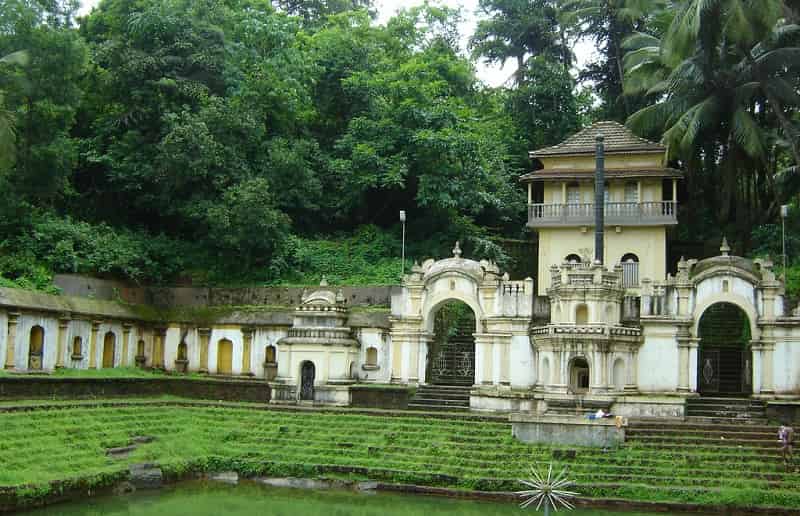
The Laxmi Narasimha temple was initially located in the Sankhavali and was later on moved in with the other deities like those of Sri Vijayadurga and Sri Shantadurga to its current place of the Sylvan surroundings. The temple is very old and was built in the 18th century and as the name suggests the temple is dedicated to the Hindu God, Vishnu and Goddess Laxmi. The temple still retains its old charm quite unlike the other Hindu temples in Goa. The architecture of the temple is very old and one feels as if you have gone back to the Vedic times as the roof of the temple still glitters like gold, the carvings are very intricate and still there are wooden bars which take you back to the 18th century.
The Mahajans of the temple belong only to the Shankpinga Kutsa Gotra. One can see a palakhi of Sri Laxmi Narasimha, which is taken out on every Shukla Chaturdashi. The festivals of Navratri and Ramanavami are celebrated with a lot of pomp and show and the annual Yatra or procession is taken out on Magha Masa.
Shri Mahalaxmi Temple
- Address: Donshiwado, Bandora 403404 Ponda, Goa
- Timings: All days of the week 6:30 AM – 12:45 PM 4:30 PM – 8:30 PM
- Visit Duration: Around 30 minutes
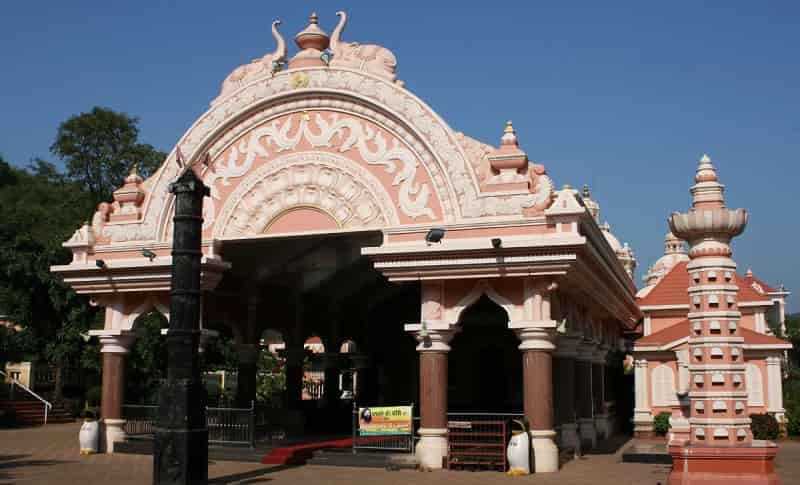
Shri Mahalaxmi Temple (Goa) which is believed to be the real house of Shakti’s cult is famous for housing the biggest galleries that showcase wooden paintings of Lord Vishnu. There is a unique thing about the temple that is the idol of Mahalaxmi Devi has a Linga on its head. The temple has the India’s largest gallery that contains wooden images of Lord Vishnu. The temple also impresses its devotees with its magnificent main square of chowka, something you would have rarely seen anywhere else.
Sri Chandreshwar Temple
- Address: 14kms from Margao, Chandranath Parvat
- Timings: 6:00 AM – 8:00 PM
- Visit Duration: 30 minutes
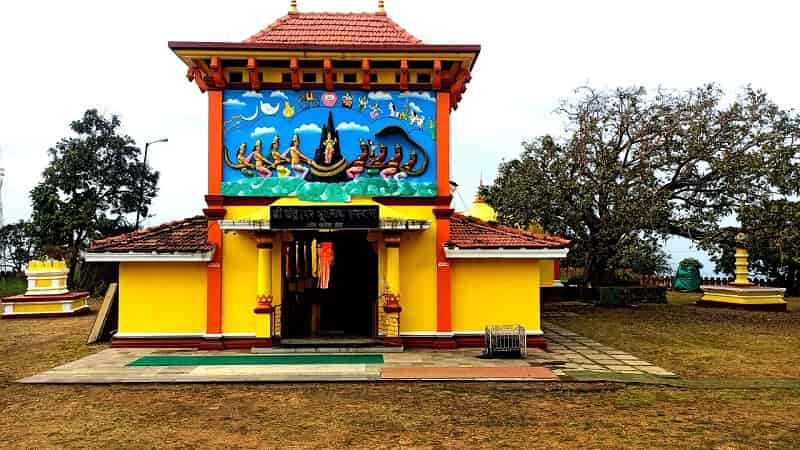
Sri Chandreshwar temple was erected in the 17th century during the reign of Bhoj Kings and was constructed in dedication to moon God on Chandreshwar hill in Paroda town. The temple is located around 45 km from Panaji city can be easily visited as the transportation is easily available to this temple.
Sri Ananta Temple
- Address: Nagar Akar Mardol Road, Kumkaliem, Goa 403115
- Timings: 8 am to 7:30 pm
- Visit Duration: 30 minutes to 1 hour
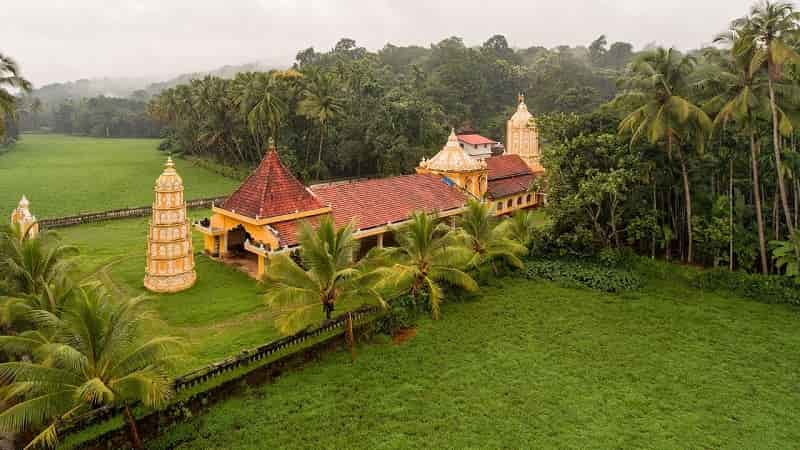
Sri Ananta temple located in the Ponda Taluka near Panaji is the most revered and eminent temple of the Hindus as it is the only temple in Goa which is dedicated to Lord Ananta which is a divine incarnation of Lord Vishnu. The idol of lord Ananta is exquisitely carved out from a black stone. The intricate architecture with pyramid formation of the temple charms the onlookers as well as the devotees who come here to seek blessing of the deity.
Shri Bhagwati Temple
- Address: 28 kms from Panaji, Pernem taluka of North Goa
- Timings: 9:30 am – 7:30 pm
- Time Required: 30 minutes
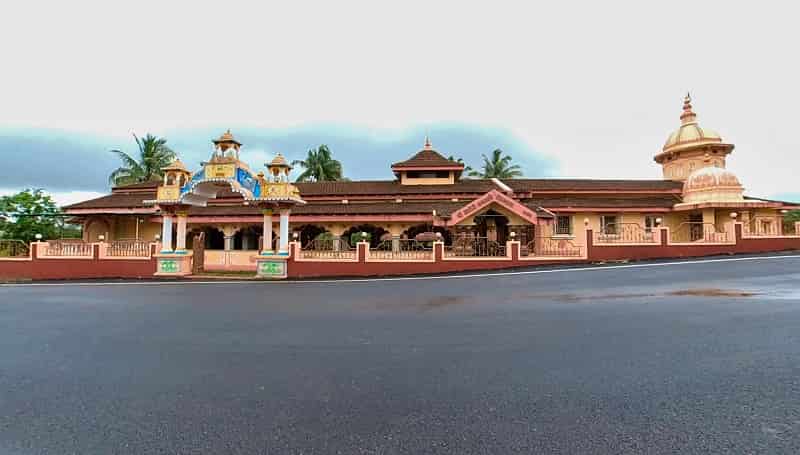
The temple dedicated to Goddess Bhagavati lies at Pernem, just north of the St. Joseph’s Church, by the side of the main road. The 500 years old temple enshrines an imposing statue of Goddess Bhagwati Asthbhuja in a standing position on a high pedestal. The temple is beautifully carved and its entrance is flanked by two life size images of elephants carved out of black stone. There are also few pillars from Kadamba period at the temple. The temple is known for the celebrations of Dussehra festival. Thousands of devotees visit the temple from Ashwin Shuddha Pratipada to Poornima.
Brahma Temple
- Address: Carambolim-Brama, Goa 403506
- Timings: 6 am – 7 pm
- Time Required: 30 minutes
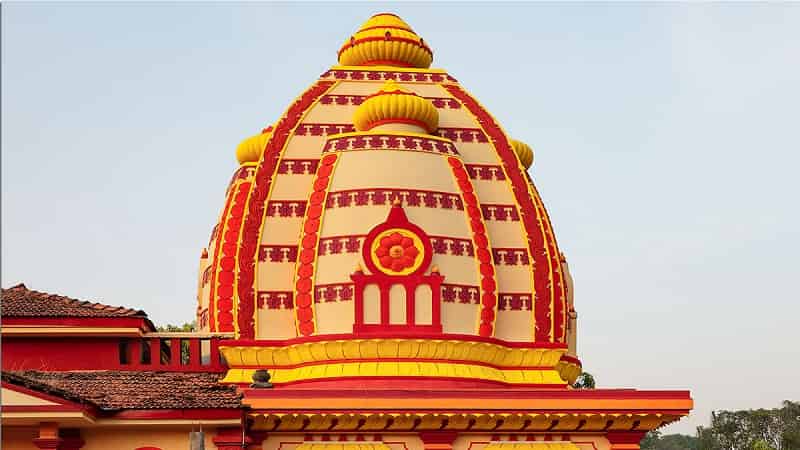
This unique shrine is located in the Satari taluka, 7 kms from Valpoi in the village of Brahma Carambolim. Originally, this 5th century temple was at Carambolim village of Tiswadi taluka and has been shifted here since 1541, after the first Portuguese conquest. It is one of the few shrines in India, dedicated to Lord Brahma. The most famous and prominent temple dedicated to Lord Brahma is at Pushkar, near Ajmer in Rajasthan. The temple can be reached by bus from Mapusa and Ponda.
Bodgeshwar Temple
- Address: Calangute – Mapusa Rd, Mapusa, Goa, 403507
- Timings: 7:30 am – 9:30 pm
- Time Required: 30 minutes
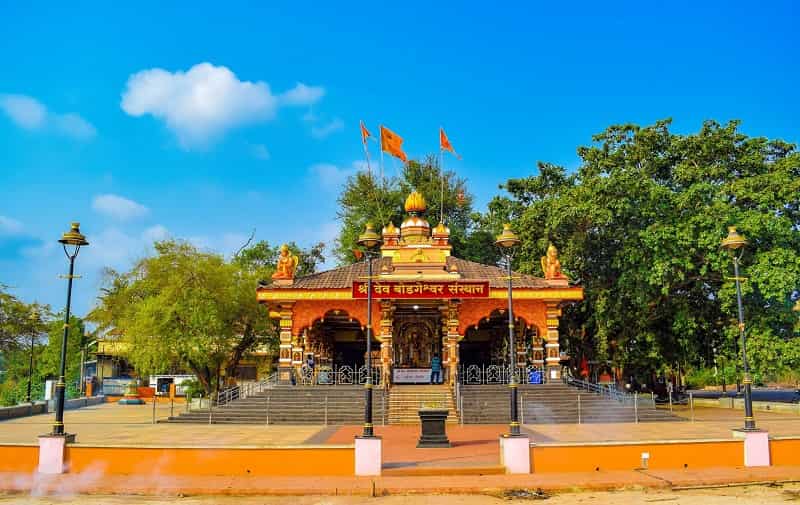
The sacred shrine lies to the south of Mapusa off the Mapusa-Panaji highway. It is dedicated to Kanakeshwar Baba, also known a Bodgeshwar, who is considered to be the deity for Angavani (to whom vows are made). Devotees have great faith in the deity and believe that Bodgeshwar fulfills all their desires. Even the buses leaving from Goa for Mumbai, stop nears the temple, to make an offering to the deity for safe passage. A grand fair is held here in Dec / Jan which is considered to be one of the largest in Goa.
Sri Damodar Temple
- Address: Zambaulim, Quepem, Goa 403705
- Timings: 7:00 to 9 pm
- Time Required: approx 1 hour
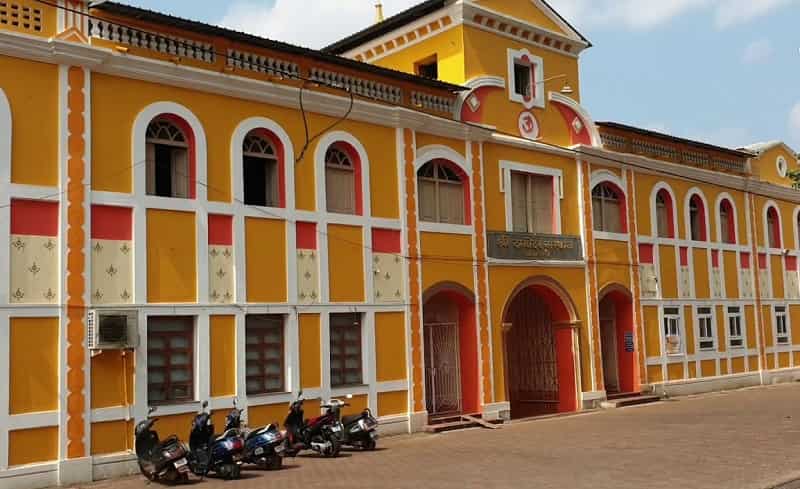
The temple is located at Zambaulim-Sanguem, about 22 km from Margao and 12 km southeast of Chandor, on the borders of Quepem and Sanguem talukas. It is set on the banks of River Kushavati, popularly known as panti. The water of the river near the temple is considered to be holy and bearing medicinal properties. The deity of the temple was originally at a temple in Margao, which was destroyed to build the Church of the Holy Spirit. The idol of the deity was rescued and brought here in 1565. The deity is worshipped by the Hindus as well as the Christians.
Sri Datta Mandir
- Address: Sanquelim near Panjim Goa – 403505
- Timings: 6:30 to 9:00 pm
- Time Required: approx 1 hour
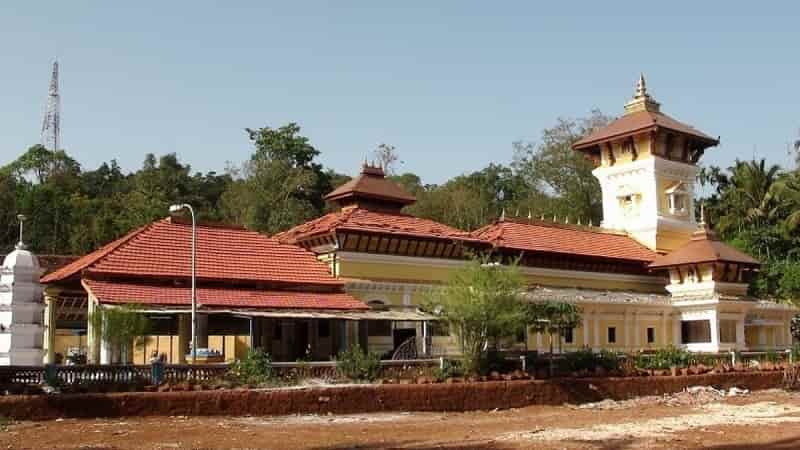
It is located at Dattawadi, Sanquelim about 37 kms from Panaji and 40 kms from Margao. The ancient shrine of Trimurthy, the Hindu trinity has a lush hill with dense groves of area palms in the back drop. The temple interiors are made in white marble and the presiding deity of is believed to have cured large number of patients with mental problems. Datta Jayanti is the most important festival of the temple, which is annually celebrated in the month of December. Large numbers of devotees from all over assemble here during this time.
